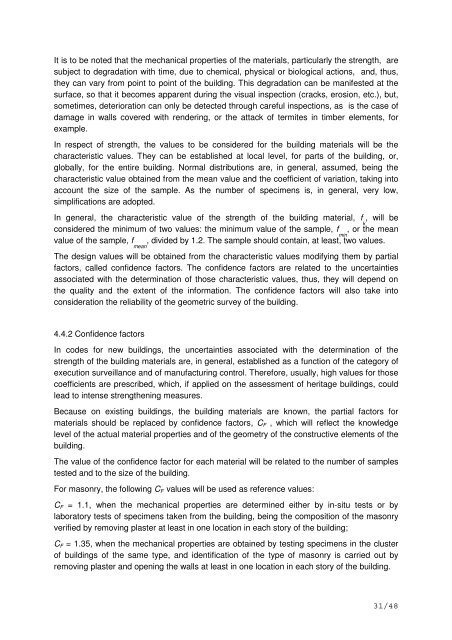Guide for the Structural Rehabilitation of Heritage ... - Test Input
Guide for the Structural Rehabilitation of Heritage ... - Test Input
Guide for the Structural Rehabilitation of Heritage ... - Test Input
Create successful ePaper yourself
Turn your PDF publications into a flip-book with our unique Google optimized e-Paper software.
It is to be noted that <strong>the</strong> mechanical properties <strong>of</strong> <strong>the</strong> materials, particularly <strong>the</strong> strength, aresubject to degradation with time, due to chemical, physical or biological actions, and, thus,<strong>the</strong>y can vary from point to point <strong>of</strong> <strong>the</strong> building. This degradation can be manifested at <strong>the</strong>surface, so that it becomes apparent during <strong>the</strong> visual inspection (cracks, erosion, etc.), but,sometimes, deterioration can only be detected through careful inspections, as is <strong>the</strong> case <strong>of</strong>damage in walls covered with rendering, or <strong>the</strong> attack <strong>of</strong> termites in timber elements, <strong>for</strong>example.In respect <strong>of</strong> strength, <strong>the</strong> values to be considered <strong>for</strong> <strong>the</strong> building materials will be <strong>the</strong>characteristic values. They can be established at local level, <strong>for</strong> parts <strong>of</strong> <strong>the</strong> building, or,globally, <strong>for</strong> <strong>the</strong> entire building. Normal distributions are, in general, assumed, being <strong>the</strong>characteristic value obtained from <strong>the</strong> mean value and <strong>the</strong> coefficient <strong>of</strong> variation, taking intoaccount <strong>the</strong> size <strong>of</strong> <strong>the</strong> sample. As <strong>the</strong> number <strong>of</strong> specimens is, in general, very low,simplifications are adopted.In general, <strong>the</strong> characteristic value <strong>of</strong> <strong>the</strong> strength <strong>of</strong> <strong>the</strong> building material, fk, will beconsidered <strong>the</strong> minimum <strong>of</strong> two values: <strong>the</strong> minimum value <strong>of</strong> <strong>the</strong> sample, fmin, or <strong>the</strong> meanvalue <strong>of</strong> <strong>the</strong> sample, fmean, divided by 1.2. The sample should contain, at least, two values.The design values will be obtained from <strong>the</strong> characteristic values modifying <strong>the</strong>m by partialfactors, called confidence factors. The confidence factors are related to <strong>the</strong> uncertaintiesassociated with <strong>the</strong> determination <strong>of</strong> those characteristic values, thus, <strong>the</strong>y will depend on<strong>the</strong> quality and <strong>the</strong> extent <strong>of</strong> <strong>the</strong> in<strong>for</strong>mation. The confidence factors will also take intoconsideration <strong>the</strong> reliability <strong>of</strong> <strong>the</strong> geometric survey <strong>of</strong> <strong>the</strong> building.4.4.2 Confidence factorsIn codes <strong>for</strong> new buildings, <strong>the</strong> uncertainties associated with <strong>the</strong> determination <strong>of</strong> <strong>the</strong>strength <strong>of</strong> <strong>the</strong> building materials are, in general, established as a function <strong>of</strong> <strong>the</strong> category <strong>of</strong>execution surveillance and <strong>of</strong> manufacturing control. There<strong>for</strong>e, usually, high values <strong>for</strong> thosecoefficients are prescribed, which, if applied on <strong>the</strong> assessment <strong>of</strong> heritage buildings, couldlead to intense streng<strong>the</strong>ning measures.Because on existing buildings, <strong>the</strong> building materials are known, <strong>the</strong> partial factors <strong>for</strong>materials should be replaced by confidence factors, C F , which will reflect <strong>the</strong> knowledgelevel <strong>of</strong> <strong>the</strong> actual material properties and <strong>of</strong> <strong>the</strong> geometry <strong>of</strong> <strong>the</strong> constructive elements <strong>of</strong> <strong>the</strong>building.The value <strong>of</strong> <strong>the</strong> confidence factor <strong>for</strong> each material will be related to <strong>the</strong> number <strong>of</strong> samplestested and to <strong>the</strong> size <strong>of</strong> <strong>the</strong> building.For masonry, <strong>the</strong> following C F values will be used as reference values:C F = 1.1, when <strong>the</strong> mechanical properties are determined ei<strong>the</strong>r by in-situ tests or bylaboratory tests <strong>of</strong> specimens taken from <strong>the</strong> building, being <strong>the</strong> composition <strong>of</strong> <strong>the</strong> masonryverified by removing plaster at least in one location in each story <strong>of</strong> <strong>the</strong> building;C F = 1.35, when <strong>the</strong> mechanical properties are obtained by testing specimens in <strong>the</strong> cluster<strong>of</strong> buildings <strong>of</strong> <strong>the</strong> same type, and identification <strong>of</strong> <strong>the</strong> type <strong>of</strong> masonry is carried out byremoving plaster and opening <strong>the</strong> walls at least in one location in each story <strong>of</strong> <strong>the</strong> building.31/48
















